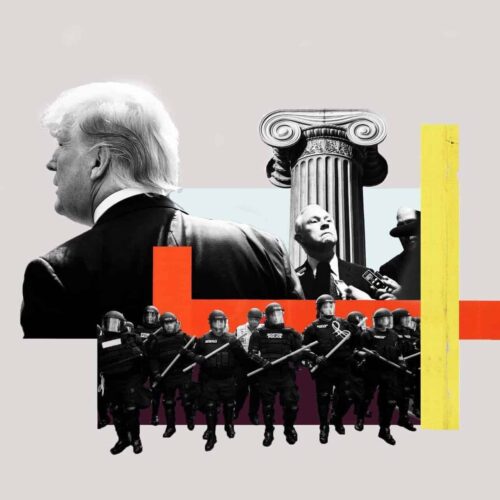This story was published in partnership with Vox. The Center for Public Integrity is a nonprofit newsroom that investigates betrayals of public trust. Sign up to receive our stories.
Introduction
Jefferson Beauregard Sessions was about to become irrelevant.
It was his last day in office. Donald Trump’s attorney general, formerly a U.S. senator from Alabama, had lost favor with the president for failing to stop the special counsel investigation into the Trump campaign’s alleged collusion with Russia in the 2016 election.
But he wasn’t quite done yet. Shortly before Sessions left the U.S. Department of Justice on Nov. 7, 2018, he circulated a memo to senior DOJ lawyers announcing a new policy.
The memo concerned consent decrees, a kind of court order negotiated between federal and state or local officials that the DOJ uses to pressure police departments with a history of systemic civil rights abuses.
Sessions’s memo marked a significant change of course from the Obama administration. It instructed the department’s lawyers to be very reluctant to pursue consent decrees. And that meant that if civil rights lawyers within the DOJ wanted to go after a particularly egregious police department, they would have to fight with at least one arm tied behind their back.
In previous administrations, consent decrees were used to fight police misconduct. The very first consent decree targeting police misconduct, a 1997 agreement President Bill Clinton’s DOJ reached with the Pittsburgh police force, briefly turned the force into a “widely emulated model department,” according to the New York Times — or, at least, it did until the decree was lifted in 2002 and the department started to backslide.
During the Obama administration, the DOJ wielded consent decrees to hold accountable wayward police departments where state and local governments would not or could not. An Obama consent decree transformed the New Orleans Police Department from one of the most corrupt in the nation into a department that other law enforcement agencies now look to for guidance. A 2016 consent decree in Ferguson, Missouri — two years after the shooting of Michael Brown — forced that town to curtail its practice of collecting escalating fines and fees from low-income residents in order to fund the town budget, and it committed the Ferguson police to deescalating their use of force.
Sessions’s memo instructed the department to “exercise special caution before entering into a consent decree with a state or local governmental entity.” It permitted DOJ lawyers to enter into such decrees only in limited circumstances. And it required that those lawyers get permission from many of the DOJ’s most senior officials before entering into a consent decree.
In practice, these restrictions have seemingly put an end to new consent decrees against police departments that systematically violate civil rights. Under President Barack Obama, the DOJ entered into consent decrees with 14 law enforcement agencies, including in places like Ferguson and Cleveland, Ohio, where police killed people. Since Trump took office, the DOJ has entered into zero consent decrees.

This abdication of the department’s previous oversight role — to police the police — can mean that no one will step in when law enforcement agencies will not obey the law.
And in a time when protesters fill the nation’s streets, Sessions’s memo means that the federal government can do far less to address these protesters’ demands for an end to police brutality.
To be clear, consent decrees are not a panacea for bad policing — some have achieved only mixed or transient results — but they have shown promise as a government tool in combating police brutality and protecting the rights and health of communities. In the best cases, they can transform — and have transformed — police departments.
But they have now been shelved, due to Sessions and the Trump administration.
Consent decrees, briefly explained
The Violent Crime Control and Law Enforcement Act of 1994 has fallen deeply out of favor with criminal justice reformers. Often referred to simply as the “crime bill,” the legislation has come to be considered “one of the cornerstone statutes that accelerated mass incarceration,” according to a recent white paper from the liberal Center for American Progress.
But a provision of this bill made it possible for the DOJ to target state and local police departments with a history of lawless behavior. Section 14141 of the crime bill permits the DOJ to investigate any “pattern or practice of conduct by law enforcement officers” that “deprives persons of rights, privileges, or immunities secured or protected by the Constitution or laws of the United States.” And if the department uncovers systemic violations within a police department, it may sue to “obtain appropriate equitable and declaratory relief to eliminate the pattern or practice.”
Which brings us to consent decrees. A key word in this phrase is “consent.” Consent decrees are agreements between two or more parties to a lawsuit — often the DOJ and a particular police department — where a party agrees to change its conduct in certain ways.
At least before the Trump administration, specialized lawyers in the DOJ’s Civil Rights Division monitored media reports, cases handled by other parts of the DOJ and even letters sent to the DOJ for signs that a particular police department had a pattern of constitutional violations. Once the DOJ decided to intervene, it could conduct a formal investigation, pressure the police department to make voluntary changes and, if necessary, file a lawsuit.
Consent decrees allow police departments to avoid expensive and protracted litigation against the federal government. Often, these agreements can be quite long and meticulously detailed. The Obama-era consent decree governing the New Orleans Police Department, for example, is more than 120 pages long, and its provisions impose very detailed requirements on the department: One requires the department to “identify official and vital documents that are subject to public dissemination and require translation of such documents into Spanish and Vietnamese.” Another requires officers to “issue three loud and clear warnings that a canine will be deployed” in most cases before a police dog may be used on a suspect.
Consent decrees differ from ordinary lawsuit settlements in that they must be approved by a judge. Once the consent decree is approved, the judge is empowered to enforce it, and they will often appoint a professional monitor who will watch over the police department and provide periodic reports on whether the department is complying with the agreement.
The presence of a monitor is key and often just as important as ensuring that a police department has good policies on its books. As Monique Dixon, deputy director of policy and director of state advocacy at the NAACP Legal Defense and Educational Fund, told me, “It’s not enough to have policies in place.” Police departments “must also have systems and mechanisms to make sure that personnel follow those policies.”
While a federal monitor cannot adjudicate every case where an officer is accused of misconduct, that monitor can notify the judge if a department has inadequate systems in place to discipline rogue officers. And the monitor’s mere existence is a reminder that someone with power over the department is keeping an eye on its actions.
Some consent decrees are more successful than others. And, because police consent decrees are a relatively recent phenomenon — police departments and the DOJ have only entered into a few dozen consent decrees since the crime bill became law — it’s hard for researchers to reach definitive conclusions about their effectiveness.
But there is evidence that, in the aggregate, consent decrees are effective at reducing civil rights violations. A 2017 study, for example, looked at 23 police departments subject to consent decrees. It found that civil rights suits against these departments “dropped anywhere from 23 percent to 36 percent after a federal intervention”— although the number of lawsuits also tended to tick up after the consent decree was lifted.Another study found that consent decrees are quite effective in reducing deaths caused by police officers, but only when police are overseen by a monitor. “In the absence of court-appointed monitors, consent decrees did not result in significant changes to the number of citizen fatalities,” writes Li Sian Goh, a PhD candidate in criminology at the University of Pennsylvania. But “when federal courts appointed monitor teams to oversee the consent decree settlement, police departments saw a 29 percent decrease in fatalities.”
Sessions’s case against consent decrees
The very idea that the federal government might assert power over a local police department forms the core of Sessions’s objection to consent decrees against those departments.
“One of the most dangerous, and rarely discussed, exercises of raw power is the issuance of expansive court decrees,” Sessions wrote in 2008, while he was still a senator. Such decrees, he claimed, “have a profound effect on our legal system as they constitute an end run around the democratic process.”Ten years later, Sessions elaborated on this reasoning in his parting memo. When a federal judge is placed in charge of implementing reforms, the outgoing attorney general claimed, “this supervision can deprive the elected representatives of the people of the affected jurisdiction of control of their government.” Instead of having local or state policing policy set by elected officials, consent decrees can transfer power to a federal judge.
“One of the most dangerous, and rarely discussed, exercises of raw power is the issuance of expansive court decrees.”
Jeff Sessions wrote in 2008 as a senator
Of course, consent decrees are negotiated agreements to avert a lawsuit, and local or state elected officials generally are represented in these negotiations. But Sessions also warned that such agreements can take away a local or state government’s ability to change its mind. “A consent decree,” according to Sessions, “can reduce long-term flexibility in how the defendant remedies the legal violation, especially if the passage of time has resulted in changed circumstances.”
Sessions claimed, in other words, that consent decrees are an attack on local control and local democracy. In some cases, DOJ lawyers may use the threat of a lawsuit to pressure local officials into accepting terms they’d otherwise refuse. In other cases, he wrote in 2008, “certain governmental agencies secretly delight in being sued because they hope a settlement will be reached” that calls for more money to be spent on the agency than the legislature otherwise would have appropriated, and that could “bind the hands of future state executives and legislatures.”
But the binary world that Sessions sketches — one that places unelected federal lawyers against democratically legitimate officials in cities and states — is not the world we live in.
The mass protests against police violence arise out of frustration that the democratic system is not working to ensure that police respect civil rights, a frustration born out of the perception that police often operate outside the democratic process — often with the support of police unions that view protecting their own as more important than ensuring that police obey the law.
Consider a Twitter thread by Steve Fletcher, a Minneapolis City Council member, explaining why political leaders have been unable to rein in the police department that employed Derek Chauvin, the white cop who pinned George Floyd, a black man, by the neck with his knee for nearly 9 minutes and who is now charged with Floyd’s murder.
As Fletcher writes, when elected leaders push policies that police find objectionable, those police can retaliate with work slowdowns or stoppages that target the elected official’s constituents. Politicians who push back too hard against police risk losing their jobs in the next election.
We can’t do this work without your support.
The tactics Fletcher describes are hardly limited to Minneapolis. In Baltimore, police responded to prosecutors’ 2015 decision to unsuccessfully charge several officers in the killing of Freddie Gray with a work stoppage known as “the pullback.” As journalist Alec MacGillis explained, “many officers responded to calls for service but refused to undertake any ‘officer-initiated’ action.” Arrests fell by more than half compared to the previous year, and crime spiked.
In a single month, May 2015, Baltimore saw 41 homicides, more than it experienced in any other month since the 1970s. Baltimore’s police department eventually entered into a consent decree with the DOJ, eight days before Obama left office.
New York police engaged in similar tactics in late 2014 and early 2015, after tensions flared between protesters, the city’s mayor and its police union — although the New York work slowdown may not have sent the message police officers hoped it would. A study found that crime actually dropped slightly during this protest by police.
The point, however, remains: The police are not always under the effective command and control of political leaders. They can selectively do their jobs in order to reward political supporters and punish opponents. And they can form tight bonds that lead them to place protecting their own above protecting the public — or obeying commands from their jurisdiction’s lawful authorities.
As Ezekiel Edwards, director of the American Civil Liberties Union’s criminal law reform project, told me, a “police department often operates like a gang, or like a crew.”
Consent decrees can enable federal officials to succeed where local officials can fail and break up this crew mentality — or, at the very least, to impose consequences on cops who behave like they are a law unto themselves.
How the DOJ can help fix rogue police departments: the case of New Orleans
The New Orleans Police Department was one of the worst — if not the worst — law enforcement agencies in the country.
In the early 1990s, more than 40 police officers were arrested for crimes such as bank robbery, rape and bribery. Underpaid cops worked off-duty “details” to supplement their income, sometimes providing security to criminal enterprises. After a drug dealer complained to the FBI that police were shaking him down for protection money, federal agents launched Operation Shattered Shield, an operation where undercover FBI agents posed as drug dealers and paid New Orleans police officers to guard buildings where the cops were told a cocaine deal was happening.
This operation caught Len Davis, a police officer who moonlighted as a middleman — doling out jobs to officers looking to get paid to guard cocaine sales — arranging the murder of a woman who had filed a police brutality complaint. Davis was eventually sentenced to death for this killing.The Davis incident triggered a round of reforms to the New Orleans Police Department — among other things, the department’s internal affairs office was replaced by a new Public Integrity Division that included several FBI agents. Yet, by the time Obama took office in 2009, the department was still in need of reform. In 2011, the DOJ released its report on a two-year investigation into the New Orleans Police Department, and it described a law enforcement agency awash in violence, incompetence and racism.
It found that in 2009, the department arrested 565 Black people under the age of 17 for serious crimes such as homicide, robbery, or aggravated assault. During the same period, just nine white people in the same age cohort were arrested for similar crimes — although about a third of New Orleans residents are white.
“Adjusting for population,” the report explains, “these figures translate to a ratio of arrest rates for both African-American males to white males and African-American females of nearly 16 to 1.” Nationwide, the ratio is approximately 3 to 1.
And then there was the violence in the department. The DOJ uncovered “many instances in which NOPD officers used deadly force contrary to NOPD policy or law.” Yet the department’s internal review process “has not found that an officer-involved shooting violated policy in at least six years, and NOPD officials we spoke with could recall only one out-of-policy finding even before that time.”
The report found officers used force unnecessarily against suspects in handcuffs and against those with mental illness. In one particularly troubling incident, an officer punched a jail inmate in the jaw after that individual spat on the back of the cop’s head — striking this individual so hard that he fell backward and hit his head on the wall. The individual was then placed, unsecured, in the back of a transport wagon and began to “roll around.” Although this individual had to be taken to a hospital for treatment, a police sergeant “approved the officer’s admitted use of force, even though, if used as described by the officer, the force was clearly retaliatory and excessive.”

In July 2012, New Orleans officials and the DOJ signed a lengthy consent decree intended to bring the city’s police department into compliance with the law. It lays out detailed rules requiring officers to deescalate their use of force, including a ban on pepper spray, and nearly three pages of rules governing the use of police dogs — the DOJ’s report found that “NOPD’s canines were uncontrollable to the point where they repeatedly attacked their own handlers.”
The consent decree required officers to be trained on when it is appropriate to stop, search, or arrest a suspect. It explicitly protects the right of bystanders to video-record officer conduct. It imposes detailed reporting requirements on the department. And it protects whistleblowers who report police misconduct, among many other things.
Eight years later, this consent decree appears to be a success. According to a 2019 report by the court-appointed monitor, police shootings declined from 20 in 2012 to just four in 2018. The number of sexual assault reports more than tripled between 2014 and 2017 — addressing a concern raised in the DOJ’s 2011 report that New Orleans police were misclassifying sexual assaults as non-criminal activity. Nearly all officers have received the training required by the consent decree. No one was bitten by a New Orleans police dog in 2018.
Similarly, a 2019 report in the Christian Science Monitor found that “serious use of force by officers has plummeted from 14 in 2013 to 1 last year” and that “the percentage of people whose interactions with police were described as pleasant and courteous rose from 53 percent in 2009 to 87 percent a decade later.”Indeed, the consent decree’s proved so successful that Judge Susie Morgan, the federal judge overseeing the decree, announced in late 2019 that the department may come into full compliance with its obligations this year.
The promise and limits of consent decrees
As protests swept across the country after the death of George Floyd, many police officers appeared determined to prove the protesters’ point — that cops are out of control and do not respect the civil rights of the people they police. As of this writing, a Google spreadsheet compiled by anti-police violence protesters includes more than 600 videos capturing alleged incidents of police misconduct against protesters.
If the DOJ sought to intervene, these incidents may themselves be sufficient reason for it to open investigations into police departments across the country. The DOJ, after all, may intervene to challenge any “pattern or practice of conduct by law enforcement officers” that “deprives persons of rights, privileges, or immunities secured or protected by the Constitution or laws of the United States” — and the right to protest is secured by the First Amendment to the Constitution.
But even when the DOJ is aggressive about opening such investigations, and even when it secures strong consent decrees, federal court decrees do not last forever. In the Supreme Court’s words, judges typically must lift a court order after “local authorities have operated in compliance with it for a reasonable period of time.”
So while Judge Morgan’s suggestion that the consent decree on New Orleans may be lifted soon is a cause for optimism — it means that the New Orleans Police Department has met most of the demands of that decree — Morgan’s nod to a future when the consent decree is lifted is also a potentially ominous sign. When released from judicial oversight, departments have been known to backslide.
That’s what seemed to happen in Pittsburgh after the consent decree binding its police department was lifted in 2002.
In 2010, Pittsburgh police beat Jordan Miles, a black 18-year-old honors student, claiming that they believed that a bulge in Miles’s coat was a gun — Miles says he had nothing in his pocket, while police later claimed it was a bottle of Mountain Dew. Subsequent reporting revealed that “between 2010 and 2015, the city had used $4.9 million in tax money to settle more than 28 civil rights-related lawsuits against the police.” By 2014, Pittsburgh Mayor Bill Peduto warned that Pittsburgh police had backslid so much that the city was close to “going into another consent decree.”
Who We Are
The Center for Public Integrity is an independent, investigative newsroom that exposes betrayals of the public trust by powerful interests.
And this in a police department that, according to the New York Times’s Sheryl Gay Stolberg, “was considered a model of progressive policing” when the consent decree lifted.
Consent decrees also cannot transform the culture of a police department overnight. For instance, a department’s existing police force may be dominated by officers who are set in their ways and who may have grown accustomed to a culture of impunity for abusive cops.
Dixon, the lawyer with the NAACP Legal Defense and Educational Fund, pointed to Cincinnati’s 2002 Collaborative Agreement as an example of a successful consent decree. But she also noted that it was successful in part because “there was a great deal of turnover in personnel.” The Cincinnati Police Department’s “culture changed some because many of the officers transitioned out and the new officers came in under new policies.”
Consent decrees are also an imperfect vehicle to address contracts with police unions that shield bad cops. After George Floyd’s death, Minneapolis Mayor Jacob Frey told the New York Times that “the elephant in the room with regard to police reform is the police union,” adding that the Minneapolis union’s contract with the city, which expired in January, can be a “nearly impenetrable barrier” to disciplining officers who engage in misconduct.
As Roy Austin, who served as a senior civil rights lawyer in the DOJ and as deputy assistant to Obama for the Office of Urban Affairs, Justice and Opportunity, told me, a city negotiating a consent decree “cannot agree to something that is contrary to its collective bargaining agreement.” Again, a key word in the phrase “consent decree” is “consent,” and a city cannot consent to a court order that conflicts with its obligations under another, existing contract.
The DOJ could potentially bring a lawsuit seeking to breach a collective bargaining agreement, if that agreement enables unlawful conduct by police, but such a suit could take years to litigate.
An additional problem with consent decrees is that they are only as good as the judges charged with approving and enforcing them. Because the DOJ has not sought any consent decrees against police since Trump took office, we do not know yet how Trump’s notoriously conservative judicial appointees will view a proposed consent decree that they are asked to approve, most likely if Trump gets voted out and a Democratic DOJ changes course. But some members of the civil rights community expressed fears that Trump’s judges could be sympathetic to Sessions’s views about federal oversight of police.
“The Trump takeover of the courts does not bode well,” said Lynda Garcia, policing campaign director for the Leadership Conference on Civil and Human Rights.
Finally, consent decrees — indeed, litigation generally — is unlikely to bring about the kind of radical change that many protesters enraged by police violence seek. Courts are not “radical or revolutionary” institutions, Edwards of the ACLU told me. They might order police officers to refrain from unjustified violence or to abandon racist practices. But they will not fundamentally rewrite state and city budgets to transfer police funding to progressive priorities such as education or affordable housing, something the “defund the police” movement calls for.
Consent decrees, in other words, are not a panacea. They do not always succeed, and even when they do, police departments can backslide after the decree is lifted. They cannot address every obstacle to good policing, and they are not a shortcut around difficult political conversations about how states and cities should allocate limited resources.
But they are a powerful tool in the hands of the federal government’s civil rights attorneys. They can drastically change the culture of a police department like the one in New Orleans. And they are one of the few mechanisms the federal government has to transform a police department in situations where state and local governments have proven unwilling or unable to do the job.
As the nation’s top law enforcement officer, Sessions should have known all this. He may be gone from the Trump administration, but his disdain for federal oversight of rogue police departments lives on.
This series was made possible through a partnership with Vox.
Read more in Money and Democracy
System Failure
A small federal agency focused on preventing industrial disasters is on life support. Trump wants it gone.
The Chemical Safety and Hazard Investigation Board is without enough voting members, and its investigations are stuck in limbo.
System Failure
Trump reduced fines for nursing homes that put residents at risk. Then COVID-19 happened.
The Obama administration cracked down on nursing homes with infection control problems. Trump reversed course.






Join the conversation
Show Comments